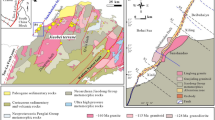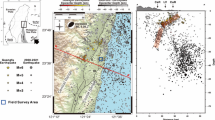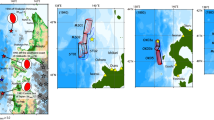Abstract
Preseismic lithospheric deformation at a subduction zone can be modelled as dip-slip dislocation on an inclined fault or as flexure of a thin plate. Both these models predict a region of positive topography known as forebulge or outer rise. By matching the location and the magnitude of the forebulge, we derive useful relations between the dip-slip fault parameters and the plate parameters. In particular, we determine the width of a long dip-slip fault of given dip corresponding to a semi-infinite plate of given thickness. The displacement profiles of the two models are also compared.
Similar content being viewed by others
References
Bott M H P 1996 Flexure associated with planar faulting:Geophys. J. Int. 126 F21-F24
Caldwell J G, Haxby D E, Karig D E and Turcotte D L 1976 On the applicability of a universal elastic trench profile;Earth Planet. Sci. Lett. 31 239–246
Chappie W M and Forsyth D W 1979 Earthquakes and bending of plates and trenches;J. Geophys. Res. 84 6729–6749
Cohen S C 1992 Postseismic deformation and stress diffusion due to viscoelasticity and comments on the modified Elasser model;J. Geophys. Res. 97 15395–15403
Cohen S C 1996 Convenient formulas for determining dip-slip fault parameters from geophysical observables;Bull. Seis. Soc. Am. 86 1642–1644
Hastie L M and Savage J C 1970 A dislocation model for the 1964 Alaska earthquake;Bull. Seis. Soc. Am. 60 1389–1392
Parsons B and Molnar P 1976 The origin of outer topographic rises associated with trenches;Geophys. J. R. Astr. Soc. 45 707–712
Rani S and Singh S J 1992 Static deformation of a uniform halfspace due to a long dip-slip fault;Geophys. J. Int. 109 469–476
Rosenbaum J G 1974 Theory of warping of southern Alaska before Alaska earthquake 1964;J. Geophys. Res. 79 3294–3301
Savage J C 1980 Dislocations in seismology, inDislocations in Solids, Vol. 3,Moving Dislocations, (ed) F R N Nabarro North-Holland, Amsterdam pp. 251–339
Savage J C and Gu G 1985 A plate flexure approximation to postseismic and interseismic deformation;J. Geophys. Res. 90 8570–8580
Singh S J and Rani S 1993 Crustal deformation associated with two-dimensional thrust faulting;J. Phys. Earth 41 87–101
Turcotte D L 1979 Flexure, inAdvances in GeophysicsVol. 21, (New York: Academic Press) pp. 51–86
Turcotte D L and Schubert G 1982Geodynamics: Applications of Continuum Physics to Geological Problems, (New York: John Wiley)
Author information
Authors and Affiliations
Rights and permissions
About this article
Cite this article
Singh, S.J., Singh, M. A note on the relationship between dip-slip fault parameters and plate parameters in the two-dimensional modelling of preseismic deformation. Proc. Indian Acad. Sci. (Earth Planet Sci.) 107, 155–160 (1998). https://doi.org/10.1007/BF02840466
Received:
Revised:
Issue Date:
DOI: https://doi.org/10.1007/BF02840466




